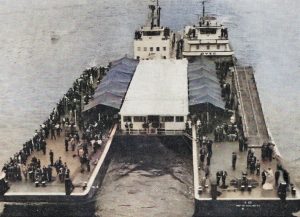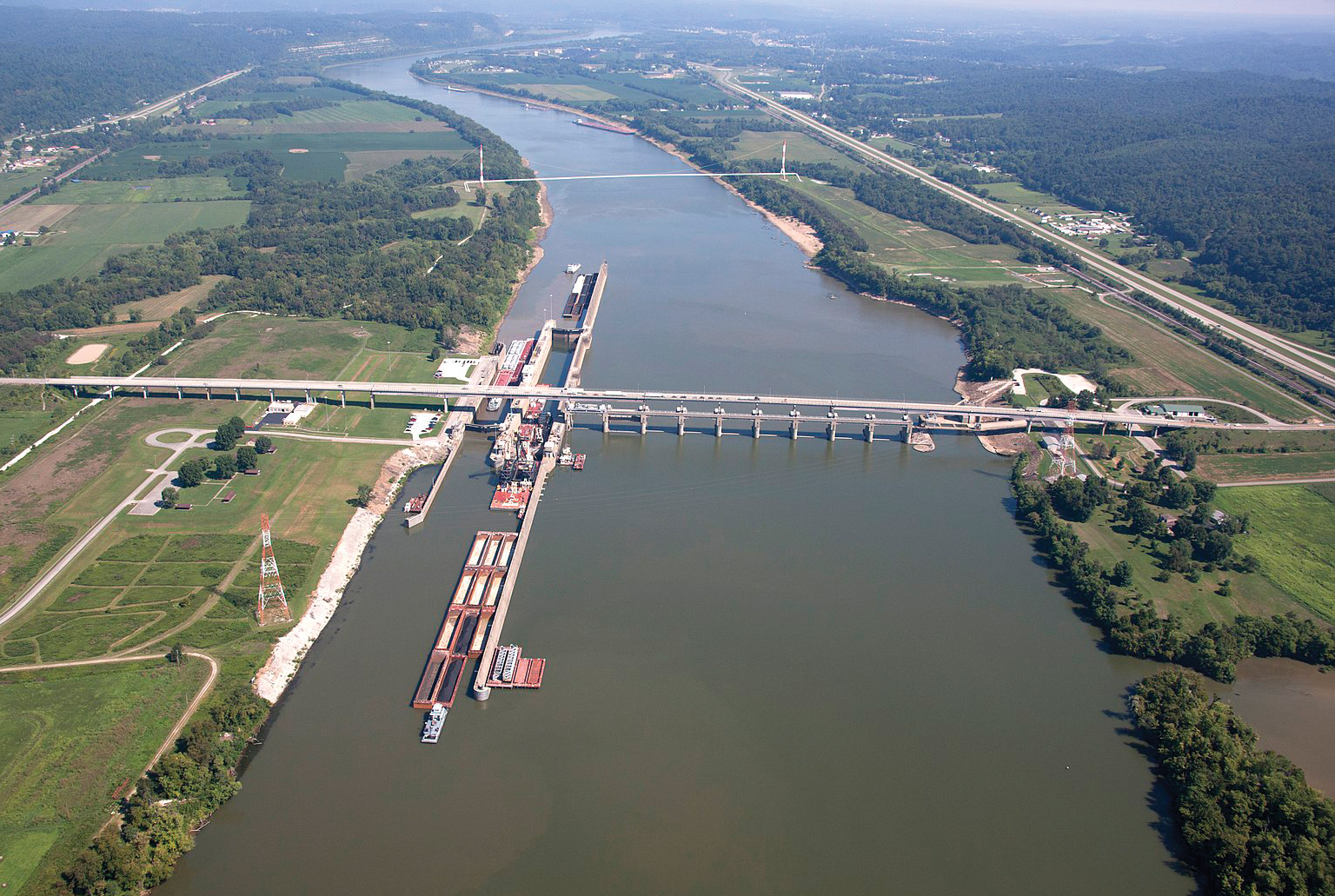The July 28, 1962, issue of The Waterways Journal, published 63 years ago today, carried a feature story on the July 22 dedication of the new Greenup Locks and Dam, located at Mile 341.1 on the Ohio River. The piece was penned by Richard Armfield, news editor of the WJ, and incorrectly gave the location as mile 515. Armfield stated that the dedication was a “ceremony which demanded a degree of co-ordination that would rival any missile launching.”
The Greenup facility had been under construction for more than eight years and cost a total of $54 million. It was the second of the modern high lift gate dams on the Ohio (after Gallipolis, dedicated in 1937) and was the largest project to date completed by Massman Construction Company of Kansas City, Kan. Many challenges had been encountered, beginning with a high-water event that caused the failure of a cofferdam on January 15, 1959. Another high water on February 27, 1961, overtopped cofferdams, resulting in the loss of a steam whirley crane and several other pieces of equipment.

Greenup had two lock chambers, a 1,200- by 110-foot main lock and a smaller 600- by 110-foot auxiliary lock. The dam contained nine “tainter” gates, 100 feet wide and 37 feet high, able to move up or down vertically to control the river. Tainter gates were named for Joseph Tainter, the 19th century captain in the U.S. Engineers who invented them. The Greenup installation was the first for the type.
The pool of the dam extends 61.8 miles upstream to the Gallipolis Dam and eliminated wicket-type dams numbers 27, 28, 29 and 30 on the Ohio River as well as Lock and Dam 1 on the Big Sandy River at Catlettsburg, Ky.
A parade of “10 of the Ohio River’s best-known boats” traveled from Ashland, Ky., downstream to the new Greenup project ahead of the dedication ceremony. Leading the procession were the 3,200 hp. Valvoline of Ashland Oil & Refining Company (AO&RCo) and the 3,240 hp. OVEC of The Ohio River Company. The two boats were lashed together abreast, and ahead of them were two AO&RCo empty barges, with a covered “party barge,” owned by Capt. R.H. Bosworth’s Point Towing Company, between them. Some 500 “water resources leaders” were aboard the barges as the procession traveled down the river.
The other boats in the parade included the still-new 4,400 hp. Oliver C. Shearer (built by Marietta Manufacturing Company in 1961), of O.F. Shearer & Sons River Transportation; the motor excursion boat Susan A of Holiday Boat Company, Gallipolis, Ohio; the 1,000 hp. Solvay of Allied Chemical Semet-Solvay Division, Ashland, Ky.; the 3,600 hp. Philip Sporn, Capt. Frank Phipps, American Commercial Barge Line, Jeffersonville, Ind.; the 760 hp. Franklin B. (built in 1961 by Yates Marine Construction), Capt. Merdie Boggs, Merdie Boggs & Sons, Catlettsburg, Ky.; the 1,100 hp. Ravenswood of Bartley Towing Inc.; and the 1,650 hp. Southland of White River Barge Line.
Also in the parade was the 480 hp. Kathy R, Capt. Ralph Raike, Ralph Raike & Son, Point Pleasant, W.Va. This was the only sternwheel towboat and the oldest boat in the procession. The Kathy R was built by Nashville Bridge Company as the Harvey in 1923 (WJ, February 12, 2021). Recognized as the first fully diesel towboat built for river service, the Kathy R was later converted to twin prop in 1964.
Robert L. Gray, manager of marine transportation for AO&RCo, was credited with spending “many hours arranging the spectacular towboat parade” and the dedication ceremony. His young son, Bob, was on hand serving as an escort to help attendees up a long ramp from the barges to the top of the lock wall. Other river company dignitaries in attendance were C.R. Walton, president of The Ohio River Company; Capt. Floyd Blaske, president of ACBL; Harry M. Mac, and Capt. Volney E. “Stogie” White of Neare, Gibbs and Company, Cincinnati; Capt. Enos Dupuis, Tennessee Towing Company; Capt. Jesse Brent with Brent Towing Company and chairman of the American Waterways Operators; C.W. “Bill” Kinzeler, Columbia Marine Service, Cincinnati; and J.T. O’Dell, transportation manager, Amherst Industries, Charleston, W.Va., who was accompanied by his 15-year-old son, Tom.
Other companies represented included Union Barge Line, Ohio Barge Line, Mississippi Valley Barge Line, Greenville Towing Company, Superior Towing Company and M.T. Epling Company, among others. Veteran journalists Robert E. “Bob” Kennedy, an employee of AO&RCo who also wrote a regular river column for the Ashland Daily Independent, and James A. Wallen, writing for the Huntington (W.Va.) Herald-Advertiser, were on hand to report on the events. Many government officials and Corps of Engineers officers were in attendance.
Armfield wrote in the WJ, “Like the Captain Anthony Meldahl Dam, now under construction downstream on the Ohio River, the Greenup Dam will stand for generations as a glorious and meaningful monument to the rivermen of yesteryear.”
The parade’s two lead towboats will be detailed in future columns. However, it is interesting that both vessels were products of St. Louis Shipbuilding & Steel Company. The Valvoline, built in 1949 as the Sohio Cleveland for Sohio Petroleum, was 150 by 35 feet, twin screw, powered by a pair of GM 16-278A engines. AO&RCo acquired and renamed it in 1950. The OVEC, built in 1956, was 164 by 44 feet, triple screw, powered by Baldwin-Lima-Hamilton engines.
————
Featured photo caption: A 2012 aerial photo of Greenup Locks and Dam. (Photo courtesy of the U.S. Army Corps of Engineers)




